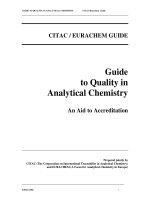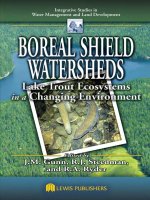BOREAL SHIELD WATERSHEDS Lake Trout Ecosystems in a Changing Environment ppt
Bạn đang xem bản rút gọn của tài liệu. Xem và tải ngay bản đầy đủ của tài liệu tại đây (9.8 MB, 528 trang )
BOREAL SHIELD
WATERSHEDS
Lake Trout Ecosystems
in a Changing Environment
Handbook of Water Sensitive Planning and Design
Edited by Robert L. France
Boreal Shield Watersheds: Lake Trout Ecosystems in a Changing Environment
Edited by J.M. Gunn, R.J. Steedman, and R.A. Ryder
Integrative Studies in
Water Management and Land Development
Series Editor
Robert L. France
Published Titles
Forests at the Wildland-Urban Interface: Conservation and Management
Edited by Mary Duryea
Restoration of Boreal and Temperate Forests
Edited by John A. Stanturf
Stormwater Management for Low Impact Development
Edited by Lawrence Coffman
The Economics of Groundwater Remediation and Protection
Paul E. Hardisty, Ece Ozdemiroglu, and Jonathan Smith
Forthcoming Titles
LEWIS PUBLISHERS
A CRC Press Company
Boca Raton London New York Washington, D.C.
BOREAL SHIELD
WATERSHEDS
Lake Trout Ecosystems
in a Changing Environment
Edited by
J.M. Gunn, R.J. Steedman,
and R.A. Ryder
This book contains information obtained from authentic and highly regarded sources. Reprinted material is quoted with
permission, and sources are indicated. A wide variety of references are listed. Reasonable efforts have been made to publish
reliable data and information, but the author and the publisher cannot assume responsibility for the validity of all materials
or for the consequences of their use.
Neither this book nor any part may be reproduced or transmitted in any form or by any means, electronic or mechanical,
including photocopying, microÞlming, and recording, or by any information storage or retrieval system, without prior
permission in writing from the publisher.
All rights reserved. Authorization to photocopy items for internal or personal use, or the personal or internal use of speciÞc
clients, may be granted by CRC Press LLC, provided that $1.50 per page photocopied is paid directly to Copyright Clearance
Center, 222 Rosewood Drive, Danvers, MA 01923 USA. The fee code for users of the Transactional Reporting Service is
ISBN 1-56670-646-7/04/$0.00+$1.50. The fee is subject to change without notice. For organizations that have been granted
a photocopy license by the CCC, a separate system of payment has been arranged.
The consent of CRC Press LLC does not extend to copying for general distribution, for promotion, for creating new works,
or for resale. SpeciÞc permission must be obtained in writing from CRC Press LLC for such copying.
Direct all inquiries to CRC Press LLC, 2000 N.W. Corporate Blvd., Boca Raton, Florida 33431.
Trademark Notice:
Product or corporate names may be trademarks or registered trademarks, and are used only for
identiÞcation and explanation, without intent to infringe.
Visit the CRC Press Web site at www.crcpress.com
© 2004 by CRC Press LLC
Lewis Publishers is an imprint of CRC Press LLC
No claim to original U.S. Government works
International Standard Book Number 1-56670-646-7
Library of Congress Card Number 2003051624
Printed in the United States of America 2 3 4 5 6 7 8 9 0
Printed on acid-free paper
Library of Congress Cataloging-in-Publication Data
Boreal shield watersheds : lake trout ecosystems in a changing environment / edited by
J.M. Gunn, R.J. Steedman, and R.A. Ryder.
p. cm. — (Integrative studies in water management and land development)
Includes bibliographical references and index.
ISBN 1-56670-646-7 (alk. paper)
1. Lake trout—Ecology. 2. Lake ecology—North America. I. Gunn, J.M. (John Maxwell), 1952-
II. Steedman, Robert John, 1958- III. Ryder, R.A. (Richard Alan) IV. Series.
QL638.S2B57 2003
597.5'54—dc21 2003051624
L1646_C00.fm Page iv Thursday, November 6, 2003 8:44 AM
v
Series statement:
Integrative studies in water
management and land
development
Ecological issues and environmental problems have become exceedingly complex. Today,
it is hubris to suppose that any single discipline can provide all the solutions for protecting
and restoring ecological integrity. We have entered an age where professional humility is
the only operational means for approaching environmental understanding and prediction.
As a result, socially acceptable and sustainable solutions must be both imaginative and
integrative in scope; in other words, garnered through combining insights gleaned from
various specialized disciplines, expressed and examined together.
The purpose of the CRC Press series Integrative Studies in Water Management and
Land Development is to produce a set of books that transcends the disciplines of science
and engineering alone. Instead, these efforts will be truly integrative in their incorporation
of additional elements from landscape architecture, land-use planning, economics, edu-
cation, environmental management, history, and art. The emphasis of the series will be
on the breadth of study approach coupled with depth of intellectual vigor required for
the investigations undertaken.
Robert L. France
Series Editor
Integrative Studies in Water Management
and Land Development
Associate Professor of Landscape Ecology
Science Director of the Center for
Technology and Environment,
Harvard University
Principle, W.D.N.R.G. Limnetics
Founder, Green Frigate Books
L1646_C00.fm Page v Thursday, November 6, 2003 8:44 AM
L1646_C00.fm Page vi Thursday, November 6, 2003 8:44 AM
vii
Foreword by series editor
This volume, edited by John Gunn, Rob Steedman, and Dick Ryder, pulls together an
incredibly broad mix of people and topics under a single cover. As such, it is a worthy
addition to the new series from CRC Press — Integrative Studies in Water Management
and Land Development — that was initiated in 2002 with publication of my own edited
volume,
Handbook of Water Sensitive Planning and Design
. Books like these are rare, but they
shouldn’t be. Complex environmental problems can only be identified, understood, and
rectified through the collective actions of a diversity of approaches from a variety of
disciplines. Gunn, Steedman, and Ryder well recognize this as witness to the fact that
their contributors to this volume come from many different provincial, state, and federal
agencies, universities, and private consulting or research organizations. Likewise, the
topics covered in these pages are truly catholic in scope: natural and cultural history,
stocking and management, rehabilitation, commercial fisheries, land-use modifications,
reservoir creation, nutrient inputs and transformations, lake chemistry and morphometry
influences, atmospheric deposition, trace contaminant cycling, species introductions, and
climatic alterations. All directed toward a single sentinel species — the lake trout of the
Boreal Shield — a wonderful fish I know well as a research subject (and also as a culinary
object!), and in an area of the continent of incredible sublime beauty in which I have spent
much time in both recreational and scholarly pursuits.
Until some future author writes a popular account of the anthropological history of
the lake trout — along the lines of, for example, John McPhee’s
The Founding Fish
(about
the shad), Mark Kurlonsky’s
Cod: A Biography of the Fish that Changed the World
, or Richard
Scheid’s
Consider the Eel
— the present book, with its emphasis on the management of,
and environmental influences on, this particular species of fish, should become widely
read. What all of these works share is their demonstration that the true distribution for
certain species of fish encompasses sociological space just as much as it does Euclidian
space. Lake trout, then, are a truly integrated cultural and biological symbol of the Boreal
Shield ecoregion.
Another important message that one takes away from the present book — one alluded
to several times but not formally enunciated — is of a compelling challenge to our myth
of “pristine nature” or “wilderness” free from human influences. When looking at a map
of human inhabitation in North America (or the photo of illuminated cities shown in the
first chapter), one could erroneously assume that somehow the great Boreal forest is “the
true north, strong and free” from human manipulation. What we learn from this book is
that the Boreal Shield ecosystem is really just as much a designed landscape as any on
the planet. So, in addition to the well-known artificiality of the forests due to wildfire
suppression, we now realize that since soon after glaciation, the resident relict populations
of lake trout have been repeatedly poked at and prodded by us. While in the past (and
even in the recent past), this has been mostly through direct tinkering such as fisheries
L1646_C00.fm Page vii Thursday, November 6, 2003 8:44 AM
viii Boreal Shield Watersheds: Lake Trout Ecosystems in a Changing Environment
and restocking programs, today it seems that these fish populations function as barometers
of changes in both the landscape and the airscape. We would be wise to learn the lessons
that these aquatic canaries might be able to tell us, and for this we should be indebted to
the authors of this timely and important volume.
Robert L. France
Harvard University
L1646_C00.fm Page viii Thursday, November 6, 2003 8:44 AM
ix
Foreword: An ideal icon
The lake trout, a coldwater denizen of Boreal lakes, makes an ideal icon. The spectacular
fish is a memory of its past and a vision for a desired future, an icon to stir human action
on behalf of valued and relatively unspoiled Boreal lakes. These lakes are increasingly
exposed to new and more intense human pressures. An icon can help foster the protection,
management, and restoration of these treasured systems. Can lake trout be such an icon?
Is this fish the only icon needed to stir the human passions to behave ethically for a
sustainable future? In the Pacific Northwest, anadromous salmon, Douglas fir, marine
mammals, and other components combine into a more general set of icons worth preserv-
ing because they are valued by different groups. Is the lake trout part of such a set of
effective icons for the Boreal lake systems? My answer would be a hearty “yes.”
This noble animal depends on the maintenance of a suite of aquatic, terrestrial, and
aerial environments; thus it is an indicator not only of the deep, cold, oxygenated waters,
but also of land at a landscape scale and of air at regional and global scales. Thus, the
species integrates anthropogenic pressures on the environment giving further credibility
to Barry Commoner’s first law of ecology: “Everything is related to everything else.” Does
it seem inconsistent that the icon is also the indicator? I think not. This is often the case.
This interlocking of the vision and the practice brings together excitement and technique,
purpose and strength. Is the lake trout a sufficient indicator through which to judge status,
function, and dynamics of Boreal lake ecosystems? I doubt it. The inshore fish community
would be a great indicator, but not as good an icon. The spruce and the aspen, the moose
and the wolf, and other components inform us about other facets of our influence that
could influence the lakes, and mechanisms are equally or more important as indicators.
Challenges are many: overfishing and extraction, exotics and toxins, human popula-
tion growth and expansion, energy use, and climate change. Some of these influences can
be dealt with or fixed at the local, lake, or perhaps watershed level. Others are more
provincial and linked to regional economic development that may undervalue ecosystem
sustainability. Some of the pressures are continental with transboundary movement among
nations of people, dollars, toxins, water, and exotics. Others are truly global, such as the
generation of greenhouse gases or development of carbon storage.
As I read the chapters, it became increasingly clear that some of these Boreal lakes
are more sensitive to different pressures, and that they are not all equally sensitive to the
same pressure. For example, a lake sensitive to overfishing because the trout are key to
the local economy or because an urban, recreational fishing population is only a short
drive away may not be the same lake that is most vulnerable to climate warming or aerially
borne toxics or acids. Of this the writers are well aware.
More daunting was the realization that some lakes we can protect, some we can
manage to some degree, some we can restore, but others we cannot help, at least in the
short term or through local action. Changes will occur, and one needs to decide how to
L1646_C00.fm Page ix Thursday, November 6, 2003 8:44 AM
x Boreal Shield Watersheds: Lake Trout Ecosystems in a Changing Environment
respond to those changes. As in the medical analogy, triage should be part of any strategy.
Behaviors in respect to short-term, faster-acting pressures may differ depending on the
expected response of Boreal lakes to the long-term drivers. Sorting such things out among
the various kinds of lakes is important to establishing short- and long-term strategies.
So from my point of view, the lake trout is certainly an icon and a tool that can help
us realize the more desirable future. The species is perhaps uniquely suited to help achieve
a sustainable future for Boreal lake ecosystems and the humans who love them. It cannot
do it alone.
John J. Magnuson
Center for Limnology
University of Wisconsin
L1646_C00.fm Page x Thursday, November 6, 2003 8:44 AM
xi
Preface: Boreal Shield ecosystems
Deep, clear Boreal Shield lakes carved from Precambrian bedrock have long defined the
northern wilderness and are the ancestral home and interglacial refuge of the lake trout,
Salvelinus namaycush
. The lakes, streams, and wetlands of this ecozone are tightly linked
to the austere watersheds of the north woods and are sustained by them. This land of
white pine, black spruce, moose, wolf, beaver, and woodland caribou poses daunting
environmental management challenges at the beginning of the 21st century. New science
gleaned from these ecosystems may provide a powerful general model for those concerned
about freshwater fisheries, water quality, and watershed ecosystems worldwide.
Humans have long been part of the Boreal Shield world. A few adaptive and resource-
ful aboriginal peoples followed fish, game, young forests, and receding glaciers northward
5000 to 10,000 years ago. The number of people living in the Boreal forest is still small
relative to those in more hospitable regions, but humans continue to move northward and
exert ever-increasing demands on the Boreal landscape. Now, 200 years after the area’s
rich fur, fish, timber, and mineral resources first attracted the interest of Europeans, forestry
and mining still form the backbone of the region’s economy. The unspoiled landscape and
waters have become easily accessible and support a huge tourism and recreation industry.
The new wave of industry and technology in distant cities now plays a dominant role in
the health of Boreal Shield ecosystems through market-driven extraction and consumption
of resources, through long-range atmospheric transportation of contaminants, and through
changing global climate.
This book brings together a uniquely qualified group of scientists to extend and
interpret the scientific legacy of the Boreal watersheds. For the last 50 years, pristine Boreal
Shield waters have served as crucibles for world-class research into impacts of water
pollution, acid rain, climate change, fisheries, and watershed disturbance. This book builds
on that research foundation and explores the ability to manage human interactions with
these unique ecosystems at local, regional, and global scales. Our ability to sustain healthy
Boreal Shield waters constitutes a crucial test of ecosystem management concepts, tech-
niques, and commitment.
John M. Gunn
Ontario Ministry of Natural Resources
Laurentian University
Robert J. Steedman
Ontario Ministry of Natural Resources
Richard A. Ryder
RAR & Associates
L1646_C00.fm Page xi Thursday, November 6, 2003 8:44 AM
L1646_C00.fm Page xii Thursday, November 6, 2003 8:44 AM
xiii
Acknowledgments
We would like to thank all the authors for their time and effort in producing these chapters.
It was a long struggle from start to finish, and we really appreciate their patience and
continued support. Special thanks to Carissa Brown and Christine Brereton, our very able
editorial assistants. This project could not have been completed without them.
Many of the authors participated as peer reviewers on associated chapters. We were
also fortunate to have the assistance of the following external reviewers: Chris Brousseau,
Randy Eshenroder, David Evans, John Fitzsimons, Chris Goddard, John Havel, Bill Keller,
Terry Marshall, Norman Mercado-Silva, Greg Mierle, George Morgan, Henk Rietveld,
Helen Sarakinos, Wolfgang Schieder, Ed Snucins, Vincent St. Louis, and James Wiener.
Michael Malette, Seija Mallory, Leila Tuhkasaari, and Amanda O’Neil (Cooperative
Freshwater Ecology Unit, Laurentian University, Sudbury, Ontario) compiled the lake trout
data set with assistance from Rob Korver, Rod Sein, and Wayne Selinger (Ontario Ministry
of Natural Resources), Michel Legault (Société de la faune et des parcs du Québec), Gary
Siesennop and Mark Ebbers (Minnesota Department of Natural Resources), and Walter
Kretser, Richard Costanza, Bill Gordon, and Richard Preall (Adirondack Lake Survey
Corporation). Paul Morgan established the Canadian Shield Trout Scholarship Program
at Laurentian University to support associated research projects. Michel Legault (Société
de la faune et des parcs du Québec) and Judi Orendorff (Ontario Ministry of Natural
Resources) participated in the original steering committee for this project. Ed Snucins and
Vic Liimatainen provided many of the photographs.
We gratefully acknowledge the Canadian National Atmospheric Chemistry
(NatChem) Database and its data-contributing agencies and organizations for the provi-
sion of the wet deposition data used to produce the 1980–1989 and 1990–1999 average
annual deposition figures (Plate 6). The agencies and organizations responsible for data
contributions to the NatChem Database include Environment Canada; the provinces of
Ontario, Quebec, New Brunswick, Nova Scotia, and Newfoundland; the U.S. Environ-
mental Protection Agency; and the U.S. National Atmospheric Deposition Pro-
gram/National Trends Network.
Information and maps for the long-term monitoring sites were provided by John
Shearer (Experimental Lakes Area), Jim Rusak (North-Temperate Lakes — Trout Lake
Station), Martyn Futter (Dorset), Mark Ridgway, Trevor Midell (Harkness/Lake Opeongo),
Dean Jeffries (Turkey Lakes Watershed), Bill Keller (Sudbury Lakes), Christine Brereton
(Sudbury Lakes and Killarney Park), and John Gunn (Killarney Park).
Financial and logistic support for the project was provided by the Ontario Ministry
of Natural Resources, Laurentian University (Cooperative Freshwater Ecology Unit), and
the Sustainable Forest Management Network.
L1646_C00.fm Page xiii Thursday, November 6, 2003 8:44 AM
L1646_C00.fm Page xiv Thursday, November 6, 2003 8:44 AM
xv
About the Editors
John M. Gunn
is a senior research scientist for the Ontario Ministry of Natural Resources
and heads the Cooperative Freshwater Ecology Unit at Laurentian University. During the
past 25 years much of his research has focused on restoration ecology of acid-damaged
ecosystems in northeastern Ontario, with particular emphasis on the recovery of stressed
lake trout ecosystems. He was the recipient of several awards, including the 2000 Presi-
dent’s Award for Conservation from the American Fisheries Society.
Robert J. Steedman
is a research scientist with the Ontario Ministry of Natural Resources
in Thunder Bay, where he has led long-term, interdisciplinary studies of watershed eco-
system response to forest management and provided science-based policy advice to the
Province of Ontario. He is presently on assignment with the National Energy Board in
Calgary, Alberta, as Professional Leader, Environment.
Richard A. Ryder
is a semiretired fisheries research scientist after a 44-year career with
the Ontario Ministry of Natural Resources and its predecessor, the Ontario Department
of Lands and Forests. He is the recipient of numerous awards and honors, including most
recently an election into the National Fisheries Hall of Excellence (1999) and the Merito-
rious Service Award (2001). He has served as president of the American Fisheries Society
(1980–1981) and the Canadian Conference for Fisheries Research (1987–1988).
L1646_C00.fm Page xv Thursday, November 6, 2003 8:44 AM
L1646_C00.fm Page xvi Thursday, November 6, 2003 8:44 AM
xvii
Contributors
Craig J. Allan
Department of Geography and Earth
Sciences
University of North Carolina at Charlotte
Charlotte, North Carolina
Jean Benoît
Direction de l’aménagement de la faune de
Lanaudière
Société de la faune et des parcs du Québec
Repentigny, Québec
Roger Bérubé
Hydraulique et Environnement
Hydro-Québec
Montréal, Québec
R.A. (Drew) Bodaly
Freshwater Institute
Department of Fisheries and Oceans
Winnipeg, Manitoba
Arthur J. Bulger
Department of Environmental Sciences
University of Virginia
Charlottesville, Virginia
Thomas J. Butler
Center for the Environment
Cornell University
Ithaca, New York
Leon M. Carl
Great Lakes Science Center
Ann Arbor, Michigan
John M. Casselman
Aquatic Research and Development
Section
Ontario Ministry of Natural Resources
Glenora Fisheries Station
Picton, Ontario
Bev J. Clark
Dorset Environmental Science Centre
Ontario Ministry of the Environment
Dorset, Ontario
Christopher S. Cronan
Department of Biological Sciences
University of Maine
Orono, Maine
Peter J. Dillon
Environmental and Resource Studies
Trent University
Peterborough, Ontario
Charles T. Driscoll
Department of Civil and
Environmental Engineering
Syracuse University
Syracuse, New York
Warren I. Dunlop
Southcentral Science and Information
Section
Ontario Ministry of Natural Resources
Bracebridge, Ontario
L1646_C00.fm Page xvii Thursday, November 6, 2003 8:44 AM
xviii Boreal Shield Watersheds: Lake Trout Ecosystems in a Changing Environment
Christopher Eagar
Northeast Forest Experiment Station
USDA Forest Service
Durham, New Hampshire
Mark P. Ebener
Great Lakes Fishery Commission
Sault Saint Marie, Michigan
Hayla E. Evans
RODA Environmental Research Limited
Lakefield, Ontario
Henri Fournier
Direction de l’aménagement de la faune de
l’Outaouais
Société de la faune et des parcs du Québec
Hull, Québec
Robert L. France
Graduate School of Design
Harvard University
Cambridge, Massachusetts
Mike Fruetel (deceased)
Quetico Mille Lacs Fisheries Assessment
Unit
Ministry of Natural Resources
Thunder Bay, Ontario
John M. Gunn
Cooperative Freshwater Ecology Unit
Ontario Ministry of Natural Resources
Laurentian University
Sudbury, Ontario
Karen A. Kidd
Department of Fisheries and Oceans
Freshwater Institute
Winnipeg, Manitoba
Charles C. Krueger
Great Lakes Fishery Commission
Ann Arbor, Michigan
Robert S. Kushneriuk
Ontario Ministry of Natural Resources
Centre for Northern Forest Ecosystem
Research
Thunder Bay, Ontario
Kathleen F. Lambert
Hubbard Brook Research Foundation
Hanover, New Hampshire
Gregory B. Lawrence
Water Resources
U.S. Geological Survey
Troy, New York
Michel Legault
Direction de la recherche sur la faune
Société de la faune et des parcs
du Québec
Québec, Québec
Nigel P. Lester
Aquatic Research and Development
Section
Ontario Ministry of Natural Resources
Peterborough, Ontario
Gene E. Likens
Institute of Ecosystem Studies
Millbrook, New York
John J. Magnuson
Center for Limnology
University of Wisconsin, Madison
Madison, Wisconsin
Nicholas E. Mandrak
Department of Fisheries and Oceans
Burlington, Ontario
Lewis A. Molot
Faculty of Environmental Studies
York University
Toronto, Ontario
Daniel Nadeau
Direction de l’aménagement de la faune de
l’Abitibi-Témiscamingue
Société de la faune et des parcs
du Québec
Rouyn-Noranda, Québec
Charles H. Olver
Ontario Ministry of Natural Resources
(retired)
Hunstville, Ontario
L1646_C00.fm Page xviii Thursday, November 6, 2003 8:44 AM
Contributors xix
Roger Pitblado
Geography Department
Laurentian University
Sudbury, Ontario
Michael J. Powell
Ontario Ministry of Natural Resources
Bracebridge, Ontario
Richard A. Ryder
RAR & Associates
Thunder Bay, Ontario
David W. Schindler
Department of Biological Sciences
University of Alberta
Edmonton, Alberta
Rod Sein
Ontario Ministry of the Environment
Northern Region
Sudbury, Ontario
Brian J. Shuter
Aquatic Research and Development
Section
Ontario Ministry of Natural Resources
Peterborough, Ontario
Robert J. Steedman
Ontario Ministry of Natural Resources
Centre for Northern Forest Ecosystem
Research
Thunder Bay, Ontario
John L. Stoddard
U.S. Environmental Protection Agency –
Corvallis Environmental Research
Laboratory
Corvallis, Oregon
M. Jake Vander Zanden
Center for Limnology
University of Wisconsin, Madison
Madison, Wisconsin
Kathleen C. Weathers
Institute of Ecosystem Studies
Millbrook, New York
Chris C. Wilson
Aquatic Research and Development
Section
Ontario Ministry of Natural Resources
Trent University
Peterborough, Ontario
Karen A. Wilson
Department of Biology
Carleton College
Northfield, Minnesota
Norman D. Yan
Biology Department
York University
Toronto, Ontario
L1646_C00.fm Page xix Thursday, November 6, 2003 8:44 AM
L1646_C00.fm Page xx Thursday, November 6, 2003 8:44 AM
xxi
Contents
Series statement: Integrative studies in water management and land development v
Robert L. France
Foreword by series editor vii
Robert L. France
Foreword: An ideal icon ix
John J. Magnuson
Preface: Boreal Shield ecosystems xi
John M. Gunn, Robert J. Steedman, and Richard A. Ryder
Section I: Introduction
Chapter 1 Lake trout, the Boreal Shield, and the factors that shape
lake trout ecosystems 3
John M. Gunn and Roger Pitblado
Chapter 2 History and evolution of lake trout in Shield lakes:
past and future challenges 21
Chris C. Wilson and Nicholas E. Mandrak
Chapter 3 Rehabilitation of lake trout in the Great Lakes: past lessons
and future challenges 37
Charles C. Krueger and Mark Ebener
Section II: Environmental factors that affect Boreal Shield ecosystems
Chapter 4 Land, water, and human activity on Boreal watersheds 59
Robert J. Steedman, Craig J. Allan, Robert L. France, and Robert S. Kushneriuk
Chapter 5 Impact of new reservoirs 87
Michel Legault, Jean Benoît, and Roger Bérubé
Chapter 6 Lake trout (
Salvelinus namaycush
) habitat volumes and boundaries
in Canadian Shield lakes 111
L1646_C00.fm Page xxi Thursday, November 6, 2003 8:44 AM
xxii Boreal Shield Watersheds: Lake Trout Ecosystems in a Changing Environment
Bev J. Clark, Peter J. Dillon, and Lewis A. Molot
Chapter 7 The effects of phosphorus and nitrogen on lake trout
(
Salvelinus namaycush
) production and habitat 119
Peter J. Dillon, Bev J. Clark, and Hayla E. Evans
Chapter 8 Dissolved organic carbon as a controlling variable in lake trout
and other Boreal Shield lakes 133
David W. Schindler and John M. Gunn
Chapter 9 Mercury contamination of lake trout ecosystems 147
R.A. (Drew) Bodaly and Karen A. Kidd
Chapter 10 Acidic deposition in the northeastern United States: Sources
and inputs, ecosystem effects, and management strategies 159
Charles T. Driscoll, Gregory B. Lawrence, Arthur J. Bulger, Thomas J. Butler,
Christopher S. Cronan, Christopher Eagar, Kathleen F. Lambert, Gene E. Likens,
John L. Stoddard, and Kathleen C. Weathers
Section III: Biological effects and management reactions
Chapter 11 The control of harvest in lake trout sport fisheries on
Precambrian Shield lakes 193
Charles H. Olver, Daniel Nadeau, and Henri Fournier
Chapter 12 Lake trout stocking in small lakes: factors affecting success 219
Michael J. Powell and Leon M. Carl
Chapter 13 Species introductions and their impacts in North American
Shield lakes 239
M. Jake Vander Zanden, Karen A. Wilson, John M. Casselman, and Norman D. Yan
Chapter 14 Effects of forestry roads on reproductive habitat and exploitation
of lake trout 265
John M. Gunn and Rod Sein
Section IV: Models and issues associated with ecosystem management
Chapter 15 Climate change and sustainable lake trout exploitation: predictions
from a regional life history model 281
Brian J. Shuter and Nigel P. Lester
Chapter 16 Monitoring the state of the lake trout resource: a landscape approach 293
Nigel P. Lester and Warren I. Dunlop
Appendix 16.1 Calculation of criteria based on lake area and TDS 323
Appendix 16.2 The effect of recruitment variability on estimating survival rates 325
L1646_C00.fm Page xxii Thursday, November 6, 2003 8:44 AM
Contents xxiii
Section V: Synthesis
Chapter 17 Boreal Shield waters: models and management challenges 331
Robert J. Steedman, John M. Gunn, and Richard A. Ryder
Section VI
Appendix 1 Long-term monitoring sites on the Boreal Shield 349
Appendix 2 Lake trout lakes of the Boreal Shield ecozone of North America 361
Appendix 3 Common and scientific names for fish species in selected
Boreal Shield lake trout lakes 481
Appendix 4 Conversion factors 483
Index 487
L1646_C00.fm Page xxiii Thursday, November 6, 2003 8:44 AM
xxiv
Photo Credits
Cover
•Front cover: Lake 223 of the Experimental Lakes Area in northwestern Ontario by
John Shearer
• Inset: Spawning lake trout (Salvelinus namaycush) at Ox Narrows, Kushog Lake, by
Skuli Skulason
Foreword
• Lake trout drawing by B.E. Harding, Game Fish and Fishing in Algonquin Park,
Government of Ontario, Department of Lands and Forests, Parks Branch, Toronto,
1955; revised 1958, 1965
Section Breaks
• Section I: Vic Liimatainen
• Section II: Ed Snucins
• Section III: Vic Liimatainen
• Section IV: Ed Snucins
• Section V: Carissa Brown
• Section VI: Steve Elliott/Mark Johnston
L1646_C00.fm Page xxiv Thursday, November 6, 2003 8:44 AM









